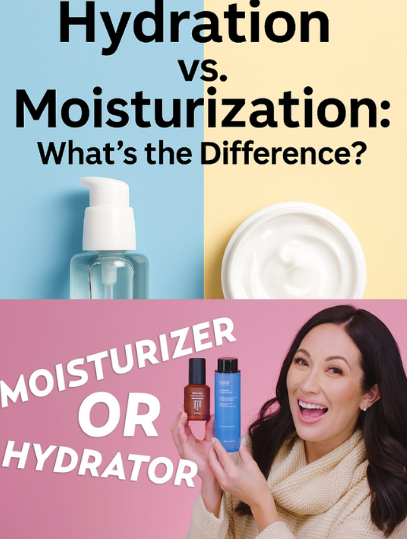
Most people use the words “hydration” and “moisturization” as if they mean the same thing. But here’s the truth—they’re not identical. Both play vital roles in skin health, yet they work in different ways. If you’ve ever wondered why some products call themselves hydrators while others are labeled moisturizers, this article will finally clear the confusion.
What Is a Moisturizer?
Moisturizers are designed to restore and strengthen your skin’s barrier while keeping water locked in. They don’t just add softness—they provide lasting protection.
Moisturizers generally contain two main types of ingredients:
- Emollients: These are lipids that fill in tiny gaps between skin cells, leaving your skin smooth and flexible.
- Occlusives: These create a protective layer over your skin to prevent water from evaporating. Think of them as cling wrap that seals in hydration.
When combined, emollients and occlusives improve barrier function, reduce itchiness, calm irritation, and even promote faster wound healing. If your skin feels dry, rough, or irritated, moisturizers help restore balance and keep your skin comfortable.
What Is a Hydrator?
Hydrators, also called humectants, attract water molecules and draw them into the outer layer of your skin. They don’t lock water in like moisturizers do—their job is to pull moisture in.
The way hydrators work depends heavily on your environment:
- In low humidity (below 50%), hydrators may pull water from deeper skin layers to the surface.
- In high humidity (above 50%), they can pull water directly from the air and bind it to your skin.
Humectants like glycerin, hyaluronic acid, and aloe vera are excellent for replenishing water levels in dehydrated skin.
Hydrator vs Moisturizer: What’s the Difference?
Although both improve your skin’s look and feel, the way they function is distinct:
- Hydrators: Attract and increase water in your skin’s surface layer.
- Moisturizers: Lock in that water and prevent it from escaping.
Both are important for soft, supple, and healthy skin. If your skin only gets water but can’t keep it, hydration fades quickly. And if your skin only locks in moisture but lacks hydration, it can feel tight and dull.
How to Tell If a Product Is a Hydrator or Moisturizer
The best way to know is by checking the ingredient list. Here are some common ingredients to look out for:
- Hydrators: Hyaluronic acid, glycerin, aloe vera, citric acid, lactic acid.
- Moisturizers: Shea butter, beeswax, mineral oil, petroleum jelly, lanolin, nut and seed oils (coconut, almond, hemp), plant oils (squalene, jojoba, rosehip, tea tree).
Some products contain a combination of both, which is ideal if your skin struggles with dryness or dehydration.
Video : Hydrator or Moisturizer: What’s the Difference? | Beauty with Susan Yara
Does Your Skin Need Hydration or Moisture?
Your skin type and condition determine whether you need hydration, moisturization, or both. Let’s break it down:
- Dry Skin:
If your skin feels rough, flaky, and tight all year round, you need both hydration and moisture. Your skin isn’t drawing in enough water and it struggles to retain what little it gets. Look for products that combine humectants and occlusives for long-term relief. - Dehydrated Skin:
Any skin type can become dehydrated—even oily skin. Dehydration is caused by low water content due to external factors like weather, diet, or excessive sweating. Signs include dullness, more visible fine lines, and tightness. In this case, focus on hydrators like hyaluronic acid or glycerin to boost water levels. - Oily Skin:
Extra shine doesn’t mean your skin is hydrated. Oily skin often produces excess sebum because the barrier is compromised, leading to dehydration. To balance this, use products with both hydrating and moisturizing ingredients. This keeps skin nourished without triggering more oil production.
Why Both Are Essential for Healthy Skin
Think of hydration and moisturization like a sponge:
- Hydration fills the sponge with water.
- Moisturization wraps the sponge in a plastic bag so the water doesn’t evaporate.
Without hydration, your skin cells shrink, making your complexion look dull and fine lines more pronounced. Without moisture, any hydration you’ve added simply disappears into the air.
How to Build a Routine That Covers Both
- Start with a Hydrating Serum
Apply a serum rich in humectants like hyaluronic acid or glycerin on slightly damp skin. This helps pull in maximum water. - Layer a Moisturizer on Top
Follow with a moisturizer containing emollients and occlusives to trap hydration inside and support the barrier. - Adjust to Climate and Skin Needs
- In dry climates, focus more on occlusive moisturizers.
- In humid environments, light hydrators often do the trick.
- Don’t Forget Sunscreen
Sun damage weakens your barrier, causing both dehydration and dryness. Daily SPF is non-negotiable.
Video : Which is the Best Moisturizer? | Rating Moisturizers as Dermatologist| Moisturiser for oily/dry skin
Conclusion
Hydration and moisturization may sound similar, but they play unique roles in skin health. Hydrators attract and replenish water, while moisturizers lock that water in and protect the barrier. Your skin needs both to look radiant, plump, and resilient.
The next time you shop for skincare, check the labels. If you want lasting results, aim for a product that delivers hydration and moisture. That’s the ultimate recipe for skin that not only looks healthy but feels incredible too.


